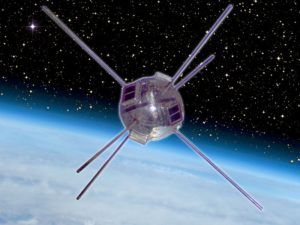On March 17th, 1958 the United States Navy successfully launched a satellite in its Vanguard program, Vanguard 1.
This was the same type of rocket and payload as in the failed Vanguard TV-3 incident that embarrassed the United States back in December of 1957, and another test in February 1958 which also ended in failure. This time, however, the launch was a success, and the payload was put into orbit successfully. This marked the 4th successful satellite launch in history, and while Vanguard was simply a test program, it had an interesting legacy regarding longevity of orbits.
The orbit of Vanguard 1 is quite high, and as such it experiences little aerodynamic drag by the fringes of Earth’s atmosphere. The spherical shape of the satellite also helps in that it has a very low drag profile in and of itself, and as such it’s going to stay in orbit for quite a long time.
 Originally planned for 2,000 years, later estimates show with solar radiation affecting the density of the outer atmosphere it will stay in orbit probably only about 240 years. This means however, regardless, that Vanguard 1 is still in orbit around the Earth. Right now, as you read this it’s still circling around, it’s electronics long ago having failed in 1964, a silent yet still under the right conditions optically track-able fragment of the earliest days of the Space Race.
Originally planned for 2,000 years, later estimates show with solar radiation affecting the density of the outer atmosphere it will stay in orbit probably only about 240 years. This means however, regardless, that Vanguard 1 is still in orbit around the Earth. Right now, as you read this it’s still circling around, it’s electronics long ago having failed in 1964, a silent yet still under the right conditions optically track-able fragment of the earliest days of the Space Race.
Indeed, part of the Vanguard satellite mission was to study atmospheric density, and the 3 Vanguard satellites still in orbit provide a baseline data set going back over 50 years. Impressive for what amount to inert hunks of metal drifting around our planet day in, day out, over 6 decades now in the case of Vanguard 1.
Here I have a bit of video showing the launch, with audio from the blockhouse at Launch Complex 18A, as well as ending with audio of the radio signal from Vanguard 1, showing how the spin rate changed over the course of a year into its mission.

